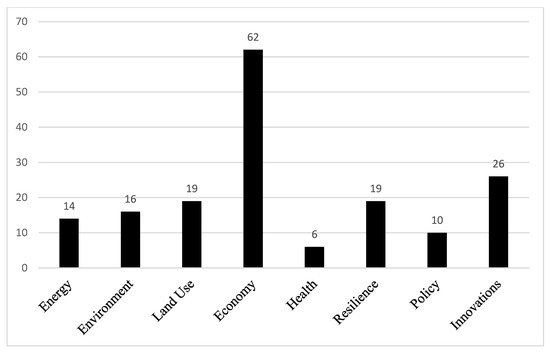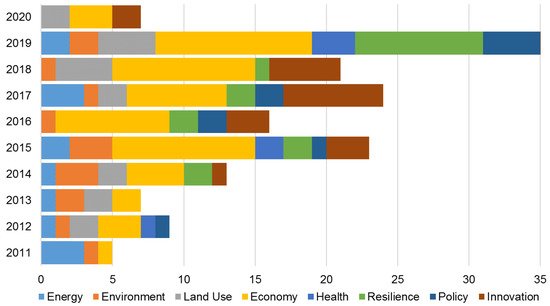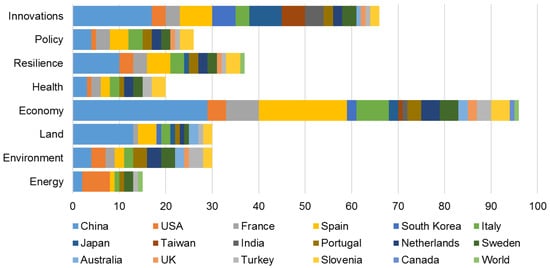Countries considering high-speed rail (HSR) developments face enormous challenges because of their high deployment cost, environmental obstacles, political opposition, and their potentially adverse effects on society. Nevertheless, HSR services are importantly sustainable that can have positive and transformative effects on the economic growth of a nation.
- socioeconomic impact
- environmental impact
- sustainability
1. Introduction
2. Socioeconomic and Environmental Impacts of High-Speed Rail
2.1. Location Distribution
The first high-speed rail system, known as the bullet train, was created in 1964 to link the Japanese cities of Tokyo and Osaka. China has the longest length of HSR in the world with 26,869 km; by comparison, the United Kingdom has about 1377 km of rail [7]. In 2009, there were more than 12,158 km of HSR in the world, which increased to more than 78,850 by 2018. Italy [8] the United Kingdom [9] and France [1] were the next countries to make HSR available to the public. In 1981, the French system connected Paris and Lyon with speeds up to 200 km/h. Today, the French high-speed rail network has expanded to more than 3220 km of rail networks that allow for speeds of up to 320 km/h. Germany’s development lasted nearly two decades [10] whereas the other developments were complete within 10 years. HSR in China has developed rapidly over the past 15 years because of generous funding from their government [11]. In the early 1990s, China started planning the current HSR network as well as the country of Norway [12], modeling it after the Shinkansen system in Japan. Korea began construction shortly after China [13].
Table 1 summarizes the length of a line in operation, under construction, and not started construction [14]. Table 1 is ordered from the largest network to the smallest. Table 1 also includes the year of construction start to the commencement of operations for the first HSR deployment in that country. The last column of Table 1 lists the number of years taken to develop and deploy the first HSR system in each country. The average time is 7.48 years, and the standard deviation is 4.82 years. The average development time for countries in the Asian continent was 8.83 years as compared with 8.25 years for European countries.
| Country | Operating Lines (km) |
New Lines (km) |
Approved | Service Start |
Build Start |
Max Speed (km/h) | Time (Years) |
|---|---|---|---|---|---|---|---|
| China | 26,869 | 10,738 | 1268 | 2008 | 1990 | 380 | 18 |
| Spain | 3100 | 1800 | 471 | 1992 | 1986 | 250 | 6 |
| Japan | 3041 | 402 | 194 | 1964 | 1959 | 320 | 5 |
| France | 3220 | 125 | 0 | 1981 | 1976 | 320 | 5 |
| Germany | 3038 | 330 | 0 | 1991 | 1973 | 300 | 18 |
| Sweden | 1706 | 180 | 0 | 1985 | 1979 | 200 | 6 |
| UK | 1377 | 230 | 320 | 1976 | 1969 | 201 | 7 |
| South Korea | 1104 | 376 | 49 | 2004 | 1992 | 300 | 12 |
| Italy | 999 | 116 | 0 | 1977 | 1970 | 250 | 7 |
| Turkey | 802 | 1208 | 1127 | 2007 | 2003 | 250 | 4 |
| Russia | 845 | 0 | 770 | 2012 | 2009 | 250 | 3 |
| Finland | 609 | 0 | 0 | 2006 | 2005 | 200 | 1 |
| Uzbekistan | 344 | 0 | 0 | 2011 | 2011 | 250 | 0 |
| Austria | 352 | 208 | 0 | 2008 | 1999 | 230 | 9 |
| Taiwan | 354 | 0 | 0 | 2007 | 1998 | 300 | 9 |
| Belgium | 326 | 0 | 0 | 1997 | 1997 | 260 | 5 |
| Poland | 224 | 0 | 484 | 2014 | 2011 | 200 | 3 |
| Netherlands | 175 | 0 | 0 | 2009 | 2000 | 300 | 9 |
| Switzerland | 144 | 15 | 0 | 2005 | 2000 | 200 | 5 |
| Luxembourg | 142 | 0 | 0 | 2007 | 2002 | 320 | 5 |
| Norway | 64 | 54 | 0 | 1998 | 1997 | 210 | 1 |
| USA | 54 | 192 | 1710 | 2030 | 2020 | 240 | 10 |
| Saudi Arabia | 453 | 453 | 0 | 2018 | 2009 | 299 | 9 |
| Denmark | 60 | 56 | 0 | 2019 | 2012 | 180 | 7 |
| Thailand | 0 | 873 | 615 | 2023 | 2017 | 250 | 6 |
| Iran | 0 | 410 | 1351 | 2021 | 2015 | 270 | 6 |
| Indonesia | 0 | 0 | 712 | 2021 | 2015 | 250 | 6 |
| India | 0 | 0 | 508 | 2023 | 2018 | 250 | 5 |
| Malaysia | 0 | 0 | 350 | 2031 | 2019 | 250 | 12 |
| Israel | 0 | 0 | 85 | 2018 | 2001 | 250 | 17 |
| Portugal | 0 | 0 | 550 | 2015 | 2000 | 250 | 15 |
| Czech Rep. | 0 | 0 | 660 | 2030 | 2017 | 250 | 13 |
| Greece | 0 | 500 | 200 | 2021 | 2018 | 250 | 3 |
2.2. Impact Area Distribution



3. Conclusions
This entry is adapted from the peer-reviewed paper 10.3390/su132112231
References
- Railway-Technology. TGV France High Speed Railways Operated by SNCF—Railway Technology. Available online: https://www.railway-technology.com/projects/frenchtgv/ (accessed on 12 June 2020).
- Lane, B.W. On the utility and challenges of high-speed rail in the United States. J. Transp. Geogr. 2012, 22, 282–284.
- Zhenga, S.; Kahn, M.E. China’s bullet trains facilitate market integration and mitigate the cost of megacity growth. Econ. Sci. 2013, 110, 1248–1253.
- Yale. High-Speed Trains Provide Environmental, Social Benefits, Study Says—Yale E360; Yale School of Forestry & Environmental Studies: New Haven, CT, USA, 2013; Available online: https://e360.yale.edu/digest/high-speed_trains_provide_environmental_social_benefits_study_says (accessed on 12 May 2020).
- Campos, J.; Rus, G.D. Some stylized facts about high-speed rail: A review of HSR experiences around the world. Transp. Policy 2009, 16, 19–28.
- Benefits of High-Speed Rail for the United States—American Public Transportation Association. APTA. Available online: https://www.apta.com/research-technical-resources/high-speed-passenger-rail/benefits-of-high-speed-rail-for-the-united-states/ (accessed on 12 May 2020).
- Post, W. High-Speed Rail Lines by Country. Available online: https://www.washingtonpost.com/wp-srv/world/highspeedrail.html?tid=grpromo (accessed on 11 July 2020).
- Alberico, U. Director. The “Direttissima” Rome—Florence Railway Line (1983)—YouTube. Film. Available online: https://www.youtube.com/watch?v=Wo35fZAe65g&t=8s (accessed on 12 September 2020).
- Railway-Technology. High Speed 2 (HS2) Railway, UK—Railway Technology. Available online: https://www.railway-technology.com/projects/high-speed-2-hs2/ (accessed on 12 September 2020).
- Railway-Technology. Germany InterCity Express High-Speed Rail Network Operated by Deutsche Bahn—Railway Technology. Available online: https://www.railway-technology.com/projects/ice-high-speed-rail/ (accessed on 12 September 2020).
- China High-Speed Rail Evolution: A Timeline of the Evolution. Available online: https://www.railway-technology.com/features/china-high-speed-rail-evolution/ (accessed on 11 July 2020).
- Railway-Technology. Norway Tilt Trains Operated by Norwegian State Railways—Railway Technology. Available online: https://www.railway-technology.com/projects/norway/ (accessed on 12 September 2020).
- Railway-Technology. TGV South Korea High-Speed Rail Route Operated by Korail—Railway Technology. Available online: https://www.railway-technology.com/projects/koreatgv/ (accessed on 12 September 2020).
- Bullet Train: Everything You Wanted to Know about Bullet Trains—What Is a High-Speed Railway? The Economic Times. Available online: https://economictimes.indiatimes.com/industry/transportation/railways/everything-you-wanted-to-know-about-bullet-trains/what-is-a-high-speed-railway/slideshow/60731138.cms (accessed on 11 July 2020).
